I’m really amused by this mead, on several levels. Obviously the name might have a familiar ring to some, but I’m actually referring to the generic ingredients: Coca leaves and Kola nuts. These ingredients were originally used in the more familiar iteration of these particular words.
In past decades, I drank a lot of modern cola industrial soft drinks, most of which were made with corn syrup and contained no coca at all. I’ve often wondered what the original formulations would have tasted like, so I decided to recreate it with a mead.
First, let’s take a closer look at these two ingredients.
Coca
In preparing for this mead, I wanted to thoroughly research coca for somewhat obvious reasons. Coca is very controversial because it contains the alkaloid cocaine, which is of course illegal and has become a problem with its use in its commercialized, concentrated form of white powder after having been extracted from the leaves. Regular Coca Leaves, in the United States, are also illegal, categorized as a Schedule II drug. What is not so widely known is that coca leaves can be “decocainized” in the same way that some coffee beans are decaffeinated. These sort of decocainized coca leaves are legal to import into the US, and are not scheduled in the same way regular coca or cocaine is:
Coca leaves (9040) and any salt, compound, derivative or preparation of coca leaves (including cocaine (9041) and ecgonine (9180) and their salts, isomers, derivatives and salts of isomers and derivatives), and any salt, compound, derivative, or preparation thereof which is chemically equivalent or identical with any of these substances, except that the substances shall not include decocainized coca leaves or extraction of coca leaves, which extractions do not contain cocaine or ecgonine.
Source:
[Code of Federal Regulations]
[Title 21, Volume 9, Parts 1300 to end]
[Revised as of April 1, 2005]
From the U.S. Government Printing Office via GPO Access
[CITE: 21CFR1308.12] [Page 94-96]
Cocaine, however, is but one of several alkaloids in the coca plant. Coca tea, in South American circles where it has been used for thousands of years, produces effects very similar to coffee, another drink from that region that Americans have grown quite accustomed to. And since it was a common ingredient in old brews including the original colas, I wanted to use it in this mead.
Kola
The Kola Tree is an evergreen tree native to west Africa. The tree produces nuts as seeds to reproduce itself. The Kola Nut, in its native land, is valued for its stimulating, aphrodisiac and healing qualities, which to me seems similar to how people use cacao in South America. The trees are related.
Kola contains a significant amount of caffeine, and as such is sometimes used as a remedy for asthma.
The cola can be extracted by boiling or tincturing the Kola nuts. For this mead, I decided to tincture the kola, which will happen after primary fermentation, after I’ve racked it into jugs for clearing it will sit with the Kola nuts to extract their colors, flavors, and other properties.
Mead
I began this mead by making a coca tea. The coca I was using was powdered, which maximizes its absorptive surface area. I was concerned about being able to filter it after the tea was done, as the powder is too fine for my screens/sieve, so I used a new kind of DIY teabag designed for a teapot (as opposed to a cup). With this sort of bag, you fill it half full of your tea (coca powder in this case):
Then, once the bag is half full, you use a common iron to seal it shut:
This left me with two large teabags containing coca leaves:
I wanted a strong Coca tea, so I decided to decoct it. On the other hand, I didn’t want it to be too tannin-y, so I opted for a short 15 minute simmer:
After the simmer, I wanted to continue to let it infuse for a few minutes. I also added a sumac drupe for its acids to help the yeast:
I let the infusion sit for about an hour, then strained the teabags and the sumac drupe out. After it cooled for several hours I poured the tea through a strainer (to get the small bits of sumac out) and added it to the pot with just under a gallon of honey, dissolving until I brought it to 17.5% alcohol potential (I wanted a strong and sweet mead for this batch):
I was left with a relatively neutral color mead, with a slightly golden hue. The mead’s color will not shift much during primary fermentation, but I expect the Kola nuts that I will add after racking to darken it considerably:
This is a somewhat complex batch with many steps, there will be several updates along the way over the next few months.
UPDATE: June 28
I racked the mead tonight, tried a bit of it, and failed to take a hydrometer reading, since I dropped the hydrometer and it shattered on my floor. Ah well. I’ll pick up a new hydrometer soon and get a reading up here.
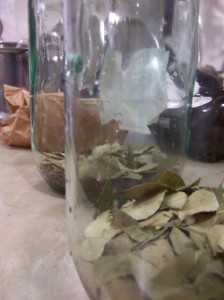
The mead tastes fantastic. It has a smooth, tangy effervescence to it (it’s not sparkling, but the tangy part of the flavor is not unlike 7up in a strange way).
I racked it into one-gallon jugs, into which I had stuffed 4 handfuls of Kola nuts and Coca leaves, so it will infuse/tincture over the coming weeks.
The mead that I racked into the waiting Kola nuts got darker very quickly, and the kola nuts caused a slight bubbling to form:
I will continue to update people as this mead develops! Very exciting, this could end up being one of the best batches yet.
UPDATE: June 29
I got a new hydrometer, so I took a reading today. It’s 4.5%, so it’s still quite sweet and about 13.5%. I’m not 100% sold on the accuracy of this reading since the “before” reading was taken with a different instrument. I don’t know how consistently calibrated these are. It does sound about right though; this mead is sweet but not cloyingly so.
Also, the bubbling has slowed down but is still happening….
UPDATE: July 27
I just tried the first bit of Coca Kola Mead. Wow! The Kola Nuts definitely add a layer of strong flavor. It’s a deep, rooty flavor, definitely reminiscent of cola, or perhaps even root beer. I need to bottle this soon so it can begin to age a bit. I imagine this will be extraordinary in a few months!

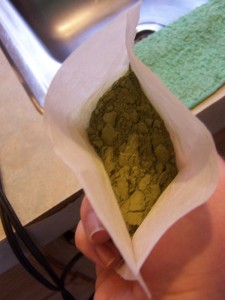
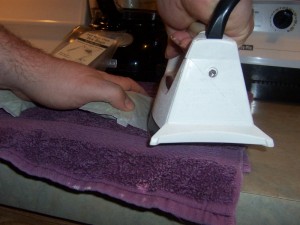


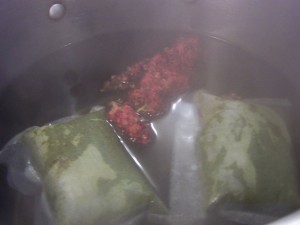
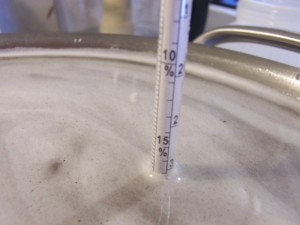


One thought on “Coca Kola Mead”
Comments are closed.